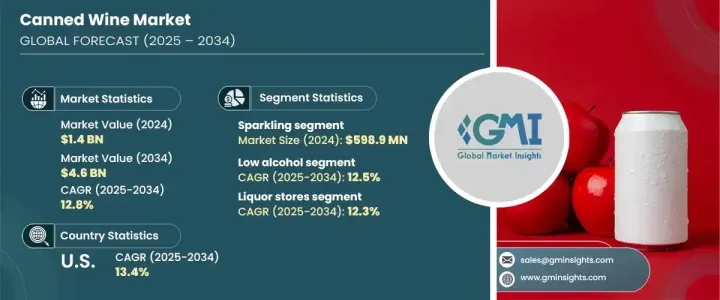
세계의 캔 와인 시장은 2024년에는 14억 달러가 되었고 2025년부터 2034년에 걸쳐 CAGR 12.8%를 나타낼 것으로 예측되어 강력한 확대가 전망되고 있습니다.
시장의 급성장은 편리하고 휴대 가능한 음료 솔루션으로 소비자의 선호도가 변화하고 있다는 배경에 있습니다. 캔 와인은 품질에 타협하지 않고 실용성을 요구하는 현대 소비자에게 최적의 선택입니다. 가볍고 비산하기 어려운 디자인은 기존의 유리병을 대체하는 뛰어난 선택이 되어 여행, 피크닉, 콘서트, 야외에서의 모임에 최적입니다. 라이프스타일이 계속 진화하는 가운데, 캔 와인의 매력은 편리성에만 머무르지 않습니다. 싱글 서브 수요가 늘어나고 있는 것은 소비자가 프리미엄 품질의 와인을 즐기면서, 소비량을 컨트롤할 것을 요구하는 마인드풀한 음주 경향의 높아짐과 일치하고 있습니다. 디지털 마케팅, 소비자에게 직접 판매, 혁신적인 포장 디자인의 등장은 시장의 매력을 더욱 높여 브랜드 참여와 고객 충성도를 촉진하고 있습니다.

2024년 스파클링 와인 부문은 5억 9,890만 달러를 차지했으며, 예측 기간의 CAGR은 12.6%를 나타낼 것으로 예상됩니다. 스파클링 와인은 전통적으로 축하 행사와 연결되어 왔지만, 현재는 캐주얼한 음주 기회의 정평이 되고 있습니다. 이 변화는 소비자가 일상 생활에서 섬세한 사치를 즐긴다는보다 광범위한 동향을 돋보이게합니다. 캔이 들어간 스파클링 와인의 편의성으로 소비자는 코르크 제거나 부패 위험 없이 고품질의 발포주를 즐길 수 있습니다. 젊은 층이 운반하기 쉽고, 빨리 마실 수 있는 것을 좋아하게 되면서, 각 브랜드는 풍미를 더한 유형로 혁신을 계속해, 보다 다양한 미각에 대응하고 있습니다.
| 시장 범위 | |
|---|---|
| 시작 연도 | 2024년 |
| 예측 연도 | 2025-2034년 |
| 시작 금액 | 14억 달러 |
| 예측 금액 | 46억 달러 |
| CAGR | 12.8% |
저알코올 와인 분야는 2024년 5억 6,630만 달러에 이르렀으며, 2025년부터 2034년까지 연평균 복합 성장률(CAGR) 12.5%를 나타낼 것으로 예상돼 큰 성장이 예측됩니다. 낮은 알코올 와인 수요 급증은 소비자의 건강 지향 증가를 반영합니다. 건강 지향 소비자는 알코올의 악영향을 최소화하면서 사교적인 음주를 즐길 수 있는 균형 잡힌 라이프 스타일을 요구하고 있습니다. 낮은 알코올 캔 와인은 기존의 와인의 풍부한 맛을 알코올 도수를 억제하여 제공하는 죄책감이없는 기호품입니다. 이 추세는 실라프 지향 증가와 일치하며, 소비자는 과다 복용 없이 사교적인 음주를 즐길 수 있는 배려 있는 방법을 찾고 있습니다. 음료 회사는 이러한 변화를 이용하여 유기농, 저당질, 자연 발효의 선택을 제공함으로써 소비자의 기대에 부응하고 있습니다.
미국의 캔 와인 시장은 2024년에 4억 4,760만 달러를 창출했고, 2034년까지의 CAGR은 13.4%를 나타내 현저한 성장이 예측되고 있습니다. 특히 밀레니얼 세대와 Z세대 사이에서 이동 중에 음료 솔루션에 대한 선호도가 높아지고 있는 것이 이 급성장에 크게 기여하고 있습니다. 이 젊은 층은 캔 와인의 운반 용이성, 환경 친화적인 포장, 다용도에 매료, 사교 모임, 야외 모험, 캐주얼 축하의 정평이되고 있습니다. 게다가, 지속가능하고 재활용 가능한 알루미늄 포장은 환경 의식의 고조에 부합하고, 캔 와인을 책임감 있는 현대적인 선택권으로 자리매김하고 있습니다. 전자상거래가 소비자의 구매 습관을 계속 변화시키는 가운데, 소비자에게 직접 판매 채널이 시장 성장을 더욱 강화하고 있습니다.
The Global Canned Wine Market was valued at USD 1.4 billion in 2024 and is set for a strong expansion, projected to grow at an impressive CAGR of 12.8% from 2025 to 2034. The market's rapid growth is fueled by shifting consumer preferences toward convenient and portable beverage solutions. Canned wine has become a go-to choice for modern consumers who seek practicality without compromising quality. Its lightweight, shatterproof design provides a superior alternative to traditional glass bottles, making it perfect for travel, picnics, concerts, and outdoor gatherings. As lifestyles continue to evolve, the appeal of canned wine extends beyond just convenience-its sustainability, portion control, and affordability contribute to its widespread adoption. The increasing demand for single-serve options aligns with the growing trend of mindful drinking, where consumers seek controlled consumption while enjoying premium-quality wines. The rise of digital marketing, direct-to-consumer sales, and innovative packaging designs further strengthen the market's appeal, driving brand engagement and customer loyalty.

In 2024, the sparkling wine segment accounted for USD 598.9 million and is expected to expand at a CAGR of 12.6% over the forecast period. Sparkling wines, traditionally linked with celebrations, are now becoming a staple for casual drinking occasions. This shift highlights a broader trend of consumers embracing small moments of indulgence in daily life. The convenience of canned sparkling wine allows consumers to enjoy high-quality bubbly without the need for a corkscrew or the risk of spoilage. As younger demographics gravitate toward easy-to-carry, ready-to-drink options, brands continue to innovate with flavor-infused varieties, catering to a more diverse range of palates.
| Market Scope | |
|---|---|
| Start Year | 2024 |
| Forecast Year | 2025-2034 |
| Start Value | $1.4 Billion |
| Forecast Value | $4.6 Billion |
| CAGR | 12.8% |
The low-alcohol wine segment reached USD 566.3 million in 2024 and is poised for substantial growth, projected to rise at a CAGR of 12.5% between 2025 and 2034. The surge in demand for low-alcohol wines reflects a growing health-conscious mindset among consumers. Wellness-focused individuals are seeking balanced lifestyle choices that allow them to enjoy social drinking while minimizing the adverse effects of alcohol. Low-alcohol canned wines provide a guilt-free indulgence, delivering the rich flavors of traditional wines with reduced alcohol content. This trend aligns with the rise of sober-curious movements, where consumers are looking for mindful ways to engage in social drinking without overconsumption. Beverage companies are capitalizing on this shift by offering organic, low-sugar, and naturally fermented options to cater to evolving consumer expectations.
The U.S. canned wine market generated USD 447.6 million in 2024 and is forecast to grow at a remarkable CAGR of 13.4% through 2034. The rising preference for on-the-go beverage solutions, particularly among Millennials and Gen Z, has significantly contributed to this surge. These younger demographics are drawn to the portability, eco-friendly packaging, and versatility of canned wine, making it a staple for social gatherings, outdoor adventures, and casual celebrations. Additionally, sustainable and recyclable aluminum packaging aligns with increasing environmental awareness, positioning canned wine as a responsible and modern choice. As e-commerce continues to reshape consumer purchasing habits, direct-to-consumer sales channels are further propelling market growth.